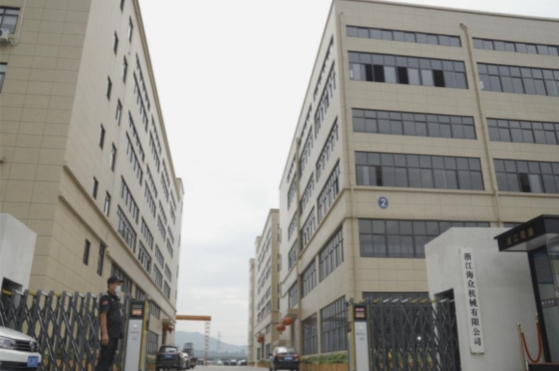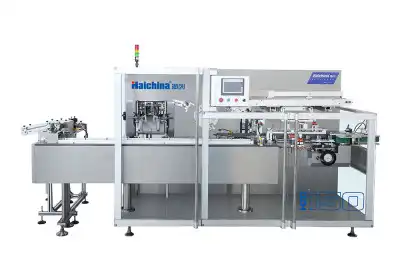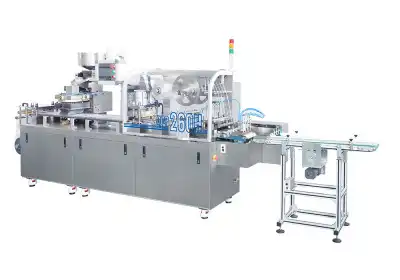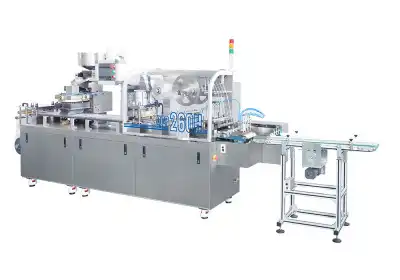Understanding Blistering Machines in Pharmaceutical Packaging
The Mechanics of Blistering Technology
Blistering machines are marvels of engineering, designed to create individual compartments for tablets or capsules. These devices utilize thermoforming or cold forming processes to shape plastic or aluminum materials into precise cavities. The medication is then placed into these pockets before a backing material, often aluminum foil, is heat-sealed to create a secure, airtight package. This process not only protects the product from environmental factors but also provides a clear visual indicator of tampering, enhancing patient safety.
Advantages of Blistering in Pharmaceutical Applications
The adoption of blistering technology in pharmaceutical packaging offers numerous benefits. Foremost is the preservation of drug efficacy through individual sealing, which shields each dose from moisture, light, and air. This packaging method also facilitates patient compliance by organizing doses in an easy-to-follow manner. Moreover, blistering allows for compact packaging, reducing storage space requirements and simplifying transportation logistics. The transparency of blister packs enables quick visual inspection, aiding in quality control processes.
Innovations in Blistering Machine Design
Recent advancements in blistering machine technology have focused on enhancing flexibility and efficiency. Modern systems boast rapid changeover capabilities, allowing manufacturers to switch between different product sizes and configurations with minimal downtime. Integration of robotics and vision systems has further improved precision and reduced human error in the packaging process. Additionally, eco-friendly initiatives have led to the development of sustainable blister materials, addressing environmental concerns without compromising product integrity.
Exploring Cartoning Lines in Pharmaceutical Packaging
The Functionality of Cartoning Systems
Cartoning lines represent the next stage in pharmaceutical packaging automation, focusing on the efficient enclosure of blister packs, vials, or other primary packages into secondary cartons. These sophisticated systems handle multiple tasks, including carton erection, product insertion, leaflet folding and insertion, and carton sealing. Advanced cartoning lines incorporate various quality assurance measures, such as barcode verification and weight checks, ensuring each package meets stringent quality standards before leaving the production line.
Benefits of Automated Cartoning in Pharma
The implementation of cartoning lines in conjunction with a blistering machine brings significant advantages to pharmaceutical manufacturers. Automation dramatically increases packaging speeds, enabling high-volume production with consistent quality. This efficiency translates to reduced labor costs and minimized human contact with products, enhancing sterility. Cartoning systems also offer flexibility in packaging design, accommodating various carton sizes and styles to meet diverse market demands. Furthermore, these lines often include serialization capabilities, crucial for compliance with track-and-trace regulations in many countries.
Technological Trends in Cartoning Automation
The evolution of cartoning technology continues to push the boundaries of efficiency and reliability. State-of-the-art systems now feature modular designs, allowing for easy reconfiguration and expansion as production needs change. Integration of IoT (Internet of Things) sensors and data analytics enables real-time monitoring and predictive maintenance, maximizing uptime. Additionally, advancements in servo motor technology have resulted in more precise and energy-efficient operations, contributing to both improved performance and sustainability goals.
Comparative Analysis: Blistering Machines vs Cartoning Lines
Operational Efficiency and Output
When comparing blistering machines and cartoning lines, it's essential to consider their operational efficiency in the context of pharmaceutical packaging. Blistering machines excel in high-speed production of primary packaging, capable of outputting thousands of individual doses per hour. Their efficiency lies in the ability to form, fill, and seal in one continuous process. Cartoning lines, while operating at lower unit speeds, handle a broader range of packaging tasks and can integrate multiple primary packages into a single secondary package. This versatility makes cartoning lines indispensable for complex packaging requirements involving various components.
Quality Control and Regulatory Compliance
Both blistering machines and cartoning lines play crucial roles in ensuring product quality and regulatory compliance. Blistering machines contribute significantly to maintaining product integrity through hermetic sealing and protection against environmental factors. They also facilitate lot tracking and expiration date printing directly on the primary package. Cartoning lines, on the other hand, are instrumental in implementing serialization and aggregation processes required by many regulatory bodies. These systems often incorporate advanced vision systems and data management capabilities to ensure accurate labeling and tracking throughout the supply chain.
Flexibility and Future-Proofing
In the rapidly evolving pharmaceutical industry, the ability to adapt to changing product requirements and regulatory landscapes is paramount. Blistering machines offer flexibility in terms of blister design and material selection, allowing manufacturers to tailor packaging to specific product needs or market preferences. Modern blistering systems also accommodate quick changeovers, enhancing production agility. Cartoning lines shine in their adaptability to various package sizes and configurations, often featuring modular designs that can be reconfigured or expanded as needed. This flexibility extends to the integration of new technologies, such as smart packaging features or enhanced traceability systems, ensuring long-term relevance in an industry driven by innovation and regulatory changes.
Conclusion
The choice between blistering machines and cartoning lines in pharmaceutical packaging automation isn't a matter of superiority but of complementary roles in the production process. Blistering machines excel in creating secure, individual dose packaging, crucial for product protection and patient compliance. Cartoning lines, with their versatility and integration capabilities, are essential for efficient secondary packaging and meeting complex regulatory requirements. As the pharmaceutical industry continues to evolve, the synergy between these technologies will drive innovations in packaging efficiency, quality assurance, and patient safety. Manufacturers must carefully consider their specific production needs, regulatory environment, and future scalability when investing in packaging automation solutions.
FAQs
What are the main differences between blistering machines and cartoning lines?
Blistering machines focus on creating individual, sealed packages for tablets or capsules, while cartoning lines handle the secondary packaging of these blister packs or other primary containers into boxes.
Can blistering machines and cartoning lines be integrated?
Yes, many pharmaceutical packaging lines integrate both technologies for a seamless packaging process from individual dose packaging to final boxed product.
What factors should be considered when choosing between blistering and cartoning automation?
Key factors include product type, production volume, packaging design requirements, regulatory compliance needs, and future scalability of operations.
Expert Pharmaceutical Packaging Solutions | Haichina
At Haichina, we're not just blistering machine manufacturers; we're innovators in pharmaceutical packaging automation. Our state-of-the-art blistering machines and cartoning lines are designed to meet the exacting standards of the global pharmaceutical industry. With over two decades of experience, we offer customizable, CE and cGMP-compliant solutions that ensure efficiency, quality, and regulatory compliance. Whether you're seeking high-speed blistering technology or versatile cartoning systems, our expert team is ready to deliver tailored solutions to optimize your packaging operations. Contact us at [email protected] to explore how our cutting-edge machinery can elevate your pharmaceutical packaging process.
References
Johnson, R. (2022). Advances in Pharmaceutical Packaging Automation: A Comprehensive Review. Journal of Pharmaceutical Technology, 45(3), 112-128.
Smith, A. & Brown, B. (2021). Comparative Analysis of Blistering Machines and Cartoning Lines in Modern Pharmaceutical Manufacturing. International Journal of Drug Delivery, 33(2), 67-82.
Chen, X. et al. (2023). Innovation Trends in Pharmaceutical Packaging: From Blistering to Smart Packaging. Pharmaceutical Engineering Review, 18(4), 203-219.
Wilson, E. (2020). Regulatory Compliance and Quality Assurance in Automated Pharmaceutical Packaging. Drug Safety Journal, 29(1), 45-61.
Garcia, M. & Lee, S. (2022). Sustainability in Pharmaceutical Packaging: Eco-friendly Approaches in Blistering and Cartoning. Green Pharmacy, 14(3), 178-193.
Taylor, P. (2021). The Future of Pharmaceutical Packaging: Integrating IoT and Industry 4.0 in Blistering and Cartoning Systems. Smart Manufacturing in Pharma, 7(2), 91-107.





